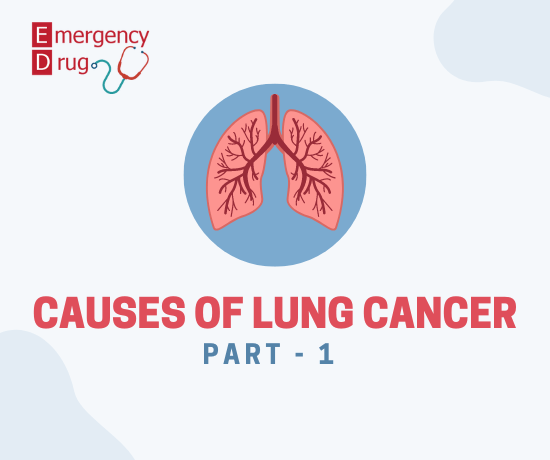Causes of Lung Cancer – Part 1
Mohammad Jewel
06 Mar, 2025


Lung cancer is cancer that forms in tissues of the lung, usually in the cells that line the air passages. It is the leading cause of cancer death in both men and women. Smoking is undeniably responsible for the majority of lung cancers, affecting both active smokers and individuals exposed to secondhand smoke. However, it is worth noting that lung cancer can also manifest in non-smokers and those with limited exposure to secondhand smoke. In such instances, the origins of the disease may not be readily identifiable, leaving medical professionals perplexed about its exact cause. The complexity of lung cancer goes beyond the conventional understanding of smoking-related risks, prompting the need for further investigation and analysis.
Table of Contents
Smoking:
There is a strong link between lung cancer and cigarette smoking, with about 90% of lung diseases caused by tobacco use. The more cigarettes you smoke, the more likely you will get lung cancer. This risk is called “pack-long stretches of smoking history” (the number of packs of cigarettes smoked every day duplicated by the number of years smoked). Suppose a man smokes two packs of cigarettes a day for a long time. This man is said to have a 20 pack-year smoking history. Those who have smoked at least ten packs a day for ten years are more likely to get lung cancer. People who have smoked at least 30 packs a day for at least 30 years are more likely to get lung cancer. One out of seven people who smoke at least two packs of cigarettes a day will die from lung cancer, which is very rare. Be that as it may, even though the risk increases the more you smoke, there is no safe level of exposure to tobacco smoke.
Pipe and stogie smoking:
Pipe and stogie smoking can also cause lung cancer, even though the risk isn’t as high as with cigarettes. One pack of cigarettes a day, smokers have a higher risk of lung cancer than nonsmokers, but pipe and cigar smokers have an even higher risk of lung cancer than nonsmokers, too. As they smoked, they looked like they were having fun.Aloof smoking, or the inward breath of used tobacco smoke from people who share living or working space, is also a risk factor for lung cancer. Research has shown that nonsmokers who live with a smoker have a 24% higher risk of getting lung disease than other nonsmokers. An estimated 7,300 people in the U.S. die from lung disease each year because they didn’t smoke.
Asbestos threads:
Asbestos filaments are silicate strands that can stay in the lungs for a long time after asbestos exposure. Asbestos was used to make materials that kept people warm and quite safe. Asbestos fibers can be found in the workplace. Asbestos is now banned or restricted in many countries, including the United States. There is a link between asbestos and lung cancer and mesothelioma, a disease that affects both the pleura and the lining of the stomach, called the peritoneum. Cigarette smoking has a huge impact on the chances of developing asbestos-related lung cancer in people who haven’t been properly trained. Asbestos workers who don’t smoke have a fivefold greater risk of lung cancer than nonsmokers, and those who smoke have a 50 to 100 times greater risk than nonsmokers.
Family history of cancer:
In this case, there is a history of cancer in the family. Some types of cancer may run in families with a faulty gene passed down. Most people who have cancer relatives won’t get a faulty gene, even if they have the same type of cancer. Cancer is more common in older persons. It is very common. One in two people in the United Kingdom will get cancer at some point in their lives. So, most families will have at least one person who has had cancer at some point in their lives. To have a cancer gene in your family, you need to have two or more relatives get cancer over 60. This doesn’t mean that you have the gene. Strength in your family history comes from.
This question is about people in your family who have had cancer:
- Who has had cancer?
- When they got sick, how old they were?
If a person has a lot of relatives who have had the same or similar types of cancer at a young age, that person has a strong family history of cancer. A faulty gene passed down from one person to another is more likely to cause cancers.
Read Causes of Lung Cancer – Part 02 To see Lung Cancer related medicine click here
